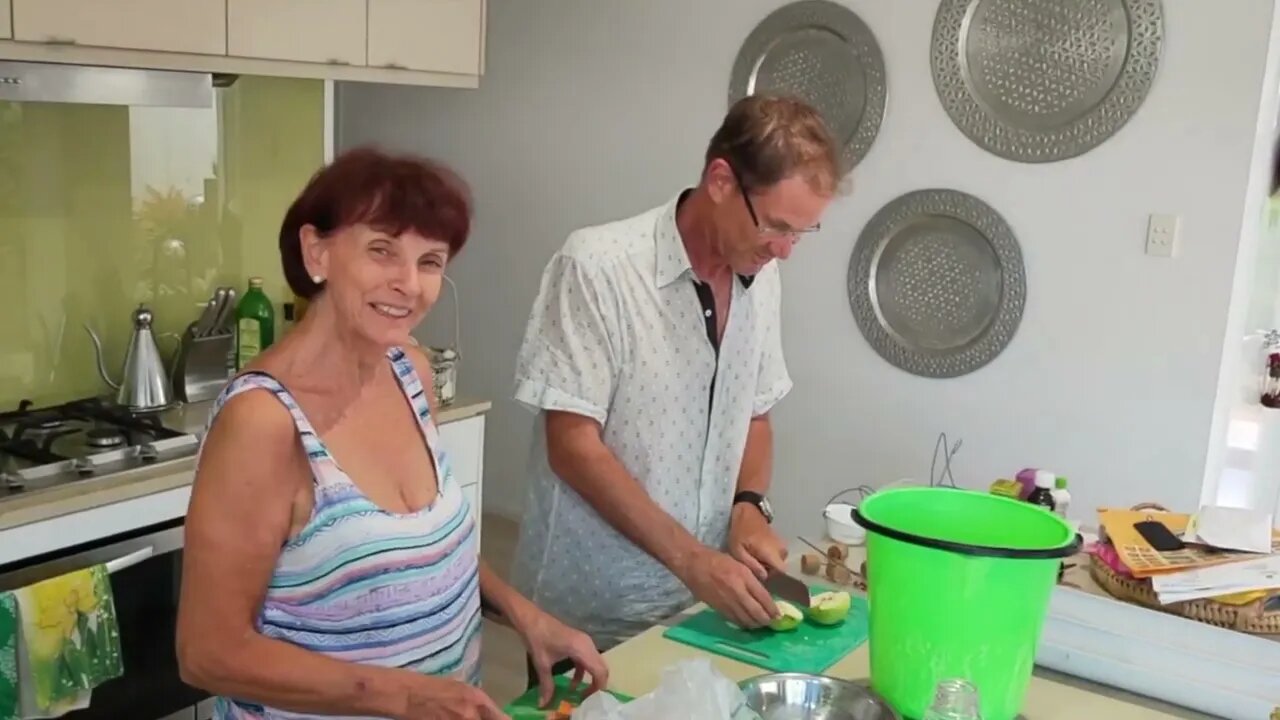Premium Only Content

Preparing And Hanging Out Food For Rescued Flying Foxes In Jeannie's Bat Aviary - Behind The Scenes
Continuing on from my previous video of a tour of Jeannie's bat aviary, this video shows you the behind-the-scenes story of what is involved in preparing food for rescued flying foxes in care.
A weaned baby bat may eat around 200-230gms of fruit a day, with an adult getting 300-350gms. This means a lot of buying fruit, fruit chopping into small pieces, especially for the babies, and then placing it around the aviary.
Yes, there is an art to the placement of the food. It has to be scattered around giving everyone a chance to get to it. Or bullies may take over a certain food container and prevent others from getting to it. Yes, its true, bats are closely related to humans, in so many ways, not just our DNA!
FLYG FOX FOOD:
Most people think bats or flying foxes only eat our backyard fruit or fruit in our commercial orchards. But they don't.
In fact, their natural food is pollen and nectar from over 100 species of native trees and vines.
They can eat the flowers and sometimes leaves of eucalypt, lily pilly, paperbark, and turpentine trees.
When native foods are scarce, particularly during drought, the bats may supplement this diet by eating fruit from introduced plants found in gardens, orchards, parks, and streetscaping.
FUNDRAISG DONATIONS:
Should you like to help with their care, then make a difference and consider donating to your local wildlife group. Even just $1 can make a big difference!
And if you are a resident of Southeast Queensland, then you could use the link: https://batrescue.org.au/donate/
All donations over $2 are fully tax-deductible.
For more videos like this, check out our playlist: "Discover Bats": https://www.youtube.com/playlist?list=PLQrN5eNL5RhOIhD8Erg2cFyPrENv1ct-8
ABOUT IRENE IACSON:
Irene Isaacson (ex-iFotoTravel) is a passionate travel and wildlife photographer. Whilst traveling over 1 million miles and across many continents over the last 10-15 years, she has honed her photography, videography, and photojournalism skills.
With a particular love of experiencing all manner of wildlife interactions, Irene is an active volunteer and member of many global wildlife organizations.
These include Not-For-Profit organizations, many of which benefit from regular donations from her photography business profits.
She shares her adventures in the hope to raise awareness of conservation and environmental issues, using her platform to inspire, support, and enact change.
Irene says: “We are all stewards of our planet. Between us all, we can help secure the future of our world and the plants and animals within it. It only needs to start with one person…”
Say Hi on Socials:
• Instagram: https://www.instagram.com/ireneisaacsonphotography
• Facebook: https://www.facebook.com/ireneisaacsonphotography
• Pinterest: https://www.pinterest.com.au/ireneisaacsonphotography
For more information:
• Email: ireneisaacsonphotography@gmail.com
• Mobile: +61 407 126 750
• Website: www.ireneisaacsonphotography.com
• For some of Irene's Travel Articles - Travel2Next: www.travel2next.com/author/irene-isaacson
For YouTube Creators – if you are not using TubeBuddy when creating your YouTube content, then click below to find out more information about the software. I find it invaluable and I think you will too:
https://www.Tubebuddy.com/ireneisaacsonphotography
#ireneisaacsonphotography #bataviary #feedingbats
-
 LIVE
LIVE
Right Side Broadcasting Network
10 days agoLIVE REPLAY: President Donald J. Trump Keynotes TPUSA’s AmFest 2024 Conference - 12/22/24
4,933 watching -
 4:31
4:31
CoachTY
22 hours ago $24.08 earnedCOINBASE AND DESCI !!!!
130K10 -
 10:02
10:02
MichaelBisping
21 hours agoBISPING: "Was FURY ROBBED?!" | Oleksandr Usyk vs Tyson Fury 2 INSTANT REACTION
67K13 -
 8:08
8:08
Guns & Gadgets 2nd Amendment News
2 days ago16 States Join Forces To Sue Firearm Manufacturers Out of Business - 1st Target = GLOCK
97.5K86 -
 10:17
10:17
Dermatologist Dr. Dustin Portela
2 days ago $17.70 earnedOlay Cleansing Melts: Dermatologist's Honest Review
137K14 -
 1:02:20
1:02:20
Trumpet Daily
2 days ago $42.82 earnedObama’s Fake World Comes Crashing Down - Trumpet Daily | Dec. 20, 2024
94.9K59 -
 6:29
6:29
BIG NEM
1 day agoCultivating God Mode: Ancient Taoist NoFap Practices
70.1K17 -
 30:53
30:53
Uncommon Sense In Current Times
2 days ago $11.03 earned"Pardon or Peril? How Biden’s Clemency Actions Could Backfire"
83.6K5 -
 40:01
40:01
CarlCrusher
1 day agoSkinwalker Encounters in the Haunted Canyons of Magic Mesa - ep 4
77.1K9 -
 59:44
59:44
PMG
2 days ago $10.28 earned"BETRAYAL - Johnson's New Spending Bill EXPANDS COVID Plandemic Powers"
78.3K49